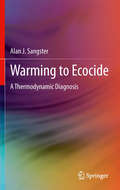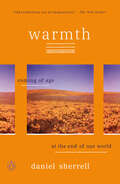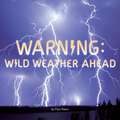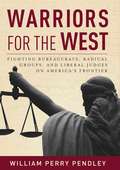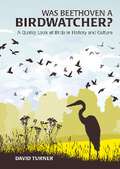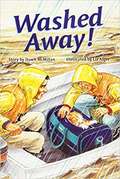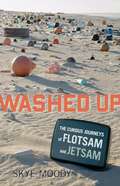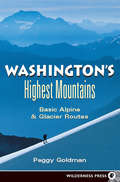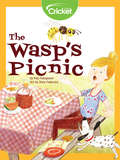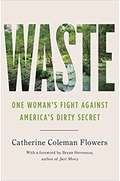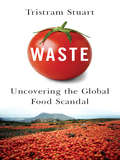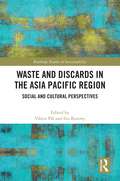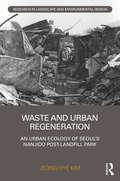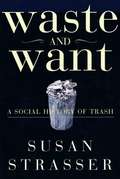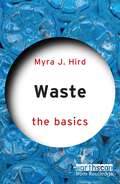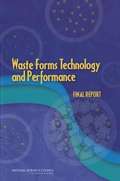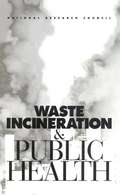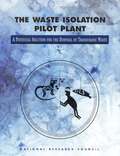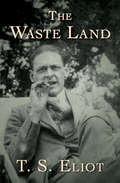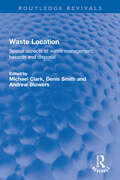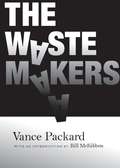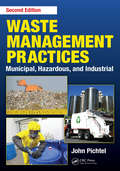- Table View
- List View
Warming to Ecocide
by Alan J. SangsterDespite scientific evidence that business-as-usual is unsustainable, there is a huge and widespread inertia to 'greening' the planet. Warming to Ecocide considers climate change from a thermodynamic perspective and asks whether market-driven organisations have carried us to the point of no return through the flawed economics of endless growth. Warming to Ecocide begins by exploring the thermodynamic origins of climate change. It demonstrates that equilibrium thermodynamics can provide full explanations for the basic processes of life such as photosynthesis and metabolism, and that non-equilibrium thermodynamics is close to providing an explanation for how life started. Armed with a solid appreciation of the power of thermodynamics, the second half of Warming to Ecocide discusses whether multinational corporations have convinced the public that climate change is insignificant and thereby neutered any all attempts by governments to espouse environmentally-friendly policies. It then goes on to offer strategies whereby mankind may avoid propelling the global average temperature above the pre-industrial level by more than 2°C, which scientists view as a threshold presaging catastrophic run-away processes.
Warmth: Coming of Age at the End of Our World
by Daniel SherrellFrom a millennial climate activist, an exploration of how young people live in the shadow of catastrophe&“Strikingly perceptive.&” —Jenny Offill, author of Weather &“Beautifully rendered and bracingly honest.&” —Jenny Odell, author of How to Do NothingWarmth is a new kind of book about climate change: not what it is or how we solve it, but how it feels to imagine a future--and a family--under its weight. In a fiercely personal account written from inside the climate movement, Sherrell lays bare how the crisis is transforming our relationships to time, to hope, and to each other. At once a memoir, a love letter, and an electric work of criticism, Warmth goes to the heart of the defining question of our time: how do we go on in a world that may not?
Warning: Wild Weather Ahead
by Theo BakerBrave the elements while learning about all kinds of weather in this informative 8x8!Where does snow come from? Why does thunder crash? What's it like inside a tornado? In this easy-to-read 8x8 readers follow a team of scientists as they launch a weather balloon in various climates to discover the answers to these common questions and more. Despite increasing knowledge of weather patterns, many kinds of weather continue to mystify experts. Discover the wild world of weather—and don't forget your umbrella!
Warriors for the West: Fighting Bureaucrats, Radical Groups, And Liberal Judges on America's Frontier
by William Perry PendleyWhy Do Americans, and Particularly Westerners, Fell Less Free?What Happened to Our Constitutional Liberties and the Rule of Law?Congress enacts ambiguous statutes demanded by radical groups; federal bureaucrats implement those laws as the groups demand; then, out-of-control activist judges, in lawsuits brought by those groups, interpret the laws as those groups insist.Meanwhile, others in Congress, the Executive, and the Judiciary do nothing!In Warriors for the West: Fighting Bureaucrats, Radical Groups, and Liberal Judges on America's Frontier, William Perry Pendley puts human faces on Westerners' historic and often precedent-setting fights against:Environmental laws"Lying and cheating" bureaucrats and their ethically challenged lawyersClinton's attacks on logging, mining, and energy explorationGovernment as a bullying bad neighborCriminalizing everything for "environmental protection"Seizure of "private property" for "public use" without "just compensation"An much, much moreNo one escapes Pendley's well-documented truth telling. All are held accountable: Congress, bureaucrats, extremist groups, and activist judges.
Was Beethoven a Birdwatcher?: A Bird's Eye History of the World
by David TurnerThis humorous and insightful guide delves into literature, science, religion, fine art and popular culture to reveal how a bird can be far more than the sum of its parts. Worshipped as gods and damned as agents of the Devil, birds have fostered scientific breakthroughs and even helped incite a war. This is full of brilliant curios.
Was Beethoven a Birdwatcher?: A Bird's Eye History of the World
by David TurnerThis humorous and insightful guide delves into literature, science, religion, fine art and popular culture to reveal how a bird can be far more than the sum of its parts. Worshipped as gods and damned as agents of the Devil, birds have fostered scientific breakthroughs and even helped incite a war. This is full of brilliant curios.
Washed Away! (Rigby PM Plus Blue (Levels 9-11), Fountas & Pinnell Select Collections Grade 3 Level Q)
by Dawn McMillanThe emergency sirens are wailing, and the flood waters have reached the end of Nicholas's street. Nicholas and his dad are ready to evacuate to the rescue centre. But what about William? Dad says cats can swim, but Nicholas won't be happy until the rains are over and he can go back home to find William.
Washed Up: The Curious Journeys of Flotsam and Jetsam
by Skye MoodyThe ocean gives up many prizes, just setting them on our beaches for us to find. From rubber ducks that started out somewhere in Indonesia to land Venice Beach, to an intact refrigerator makes it way to the Jersey Shore. Chunks of beeswax found on the Oregon coast are the packing remnants of 18th century Spanish gold. Author Skye Moody walks the coast, dons her wet suit, and heads out to sea to understand the excellent debris that accrues along the tideline. There she finds advanced military technology applied to locating buried Rolexes, hardcore competitive beachcombing conventions, and isolated beach communities whose residents are like flotsam congregated at the slightest obstacle on the coastline. This book confirms that the world is a mysterious place and that treasure is out there to be found.
Washington's Highest Mountains
by Peggy GoldmanA remarkable compendium of the most doable climbing routes up the highest peaks in Washington. Author Peggy Goldman has written this book for climbers of all abilities, but especially those "average mountaineers" wishing to increase their skills and expand their horizons in the Washington Cascades' challenging terrain. 35 trips are described, covering 61 distinct peaks, encompassing alpine and glacier climbs ranging from class 3 to class 5.
Wasps (Nature's Children)
by Jen GreenHow many kinds of wasps are there? Where do wasps live? What do wasps eat? Do all wasps sting? Find the answers to these questions, and learn much more about the physical characteristics, behavior, habitat, and lives of wasps.
The Wasp's Picnic
by Kay HaugaardStevie loves bugs—or insects, as he would say. He has lots of books about them and is always looking to see more! When the family has a picnic, a yellow jacket decides to join them, which scares their mom! Can Stevie convince his family that even though wasps are scary, they aren’t all bad?
Waste: Uncovering the Dirty Truth about Sewage and Inequality in Rural America
by Catherine Coleman Flowers Bryan StevensonMacArthur “genius” Catherine Coleman Flowers grew up in Lowndes County, Alabama, a place that's been called “Bloody Lowndes” because of its violent, racist history. Once the epicenter of the voting rights struggle, today it's Ground Zero for a new movement that is Flowers's life's work. It's a fight to ensure human dignity through a right most Americans take for granted: basic sanitation. Too many people, especially the rural poor, lack an affordable means of disposing cleanly of the waste from their toilets, and, as a consequence, live amid filth. <p><p> Flowers calls this America's dirty secret. In this powerful book she tells the story of systemic class, racial, and geographic prejudice that foster Third World conditions, not just in Alabama, but across America, in Appalachia, Central California, coastal Florida, Alaska, the urban Midwest, and on Native American reservations in the West. <p><p> Flowers's book is the inspiring story of the evolution of an activist, from country girl to student civil rights organizer to environmental justice champion at Bryan Stevenson's Equal Justice Initiative. It shows how sanitation is becoming too big a problem to ignore as climate change brings sewage to more backyards, and not only those of poor minorities.
Waste: Uncovering the Global Food Scandal
by Tristram StuartThe true cost of what the global food industry throws away. With shortages, volatile prices and nearly one billion people hungry, the world has a food problem--or thinks it does. Farmers, manufacturers, supermarkets and consumers in North America and Europe discard up to half of their food--enough to feed all the world's hungry at least three times over. Forests are destroyed and nearly one tenth of the West's greenhouse gas emissions are released growing food that will never be eaten. While affluent nations throw away food through neglect, in the developing world crops rot because farmers lack the means to process, store and transport them to market. But there could be surprisingly painless remedies for what has become one of the world's most pressing environmental and social problems. Waste traces the problem around the globe from the top to the bottom of the food production chain. Stuart's journey takes him from the streets of New York to China, Pakistan and Japan and back to his home in England. Introducing us to foraging pigs, potato farmers and food industry CEOs, Stuart encounters grotesque examples of profligacy, but also inspiring innovations and ways of making the most of what we have. The journey is a personal one, as Stuart is a dedicated freegan, who has chosen to live off of discarded or self-produced food in order to highlight the global food waste scandal. Combining front-line investigation with startling new data, Waste shows how the way we live now has created a global food crisis--and what we can do to fix it.
Waste and Discards in the Asia Pacific Region: Social and Cultural Perspectives (Routledge Studies in Sustainability)
by Viktor Pál Iris BorowyThis book uncovers, explores and analyses the cultural and social factors and values that lie behind waste making, recycling and disposal in the Asia Pacific region, where impressive economic growth has led to significant increases in production, consumption and concomitant waste production. This volume demonstrates the immense scope of waste as a multi-sectoral phenomenon, covering discussions on food, menstrual products, sewage, electronics, scrap, nuclear waste, plastics, and even entire villages as they are submerged underwater by dam building, considered expendable in favour of economic growth. It discusses the wide range of approaches and contexts through which people interact with waste, including socio-economic analysis, participatory observation, laboratory science, art, video, installations, literature and photography. Case studies focusing on India, China and Japan, in addition to other regional examples, demonstrate the ubiquity of waste, materially and geographically. It examines the duality of waste management, fostering community building while simultaneously excluding marginalised groups; how it can be linked to efforts creating circular economies, to then reappear in oceanic garbage patches; or technical waste repurposed for high-tech laboratory research before being discarded once again. This timely and wide-ranging collection of essays will be an important read for scholars, researchers and students in sustainability, development studies, discard studies, and social and cultural history, particularly focusing on countries in the Asia-Pacific.
Waste and Urban Regeneration: An Urban Ecology of Seoul’s Nanjido Post-landfill Park (Routledge Research in Landscape and Environmental Design)
by Jeong Hye KimWaste and Urban Regeneration examines the Nanjido region of Seoul and its transformation from Nanjido Landfill to the World Cup Park, and its relation to the urban ecology within the context of the city’s urban development during the late twentieth and early twenty-first centuries. The study analyses the urban ecological meanings of the site’s two distinct forms by consolidating them with the Lefebvrian urban theory and relational ecological theories. This book looks at environmental transformations and their link to South Korea’s political and economic changes; how Seoul City controlled waste populations, the borderline characterisations of the inhabited landfill and its community, the regeneration of the landfill into the post-landfill park and site-specific artworks which explored the conflict between the invisible presence of the landfill’s garbage and its history. As one of the first accounts of a landfill and landfill-turned-park of South Korea, this study is a must-read for academics and researchers interested in waste management, ecology, landscape theory and history.
Waste and Want: A Social History of Trash
by Susan Strasser(back of book) Susan Strasser's pathbreaking histories of housework and the rise of the mass market have become classics in the literature of consumer culture. Here she turns to an essential but neglected part of that culture - the trash it produces - and finds in it an unexpected wealth of meaning. Before the twentieth century, streets and bodies stank, but trash was nearly nonexistent. With goods and money scarce, everything possible was reused. Strasser paints a vivid picture of an America where scavenger pigs roamed the streets, "swill children" collected kitchen garbage, and itinerant peddlers traded manufactured goods for rags and bones. In the last hundred years, that way of life has been replaced by mass consumption, disposable goods, and waste on a previously unimaginable scale. Strasser charts the triumph of "disposable" goods - paper cups, toilet paper, packaged food - those signature products of modern life. And she shows how Americans became hooked on convenience, fashion, and constant technological change - as the mountains of garbage rose higher and higher. Lively and colorful, Waste and Want recaptures a hidden part of our social history, vividly illustrating that what counts as trash depends on who's counting, and that what we throw away defines us as much as what we keep.
Waste: The Basics (The Basics)
by null Myra J. HirdWaste: The Basics answers the questions: why are we facing a global waste crisis, and how can we effectively solve it? The book identifies the most common types of waste, its major producers, how we manage waste locally, regionally and globally, and why this management is leading to more waste.Written in a highly accessible style, the book begins with our own everyday mundane experiences of creating waste (those objects or materials we toss in the garbage or recycling bin) and shows how these practices are connected to a global system that manages waste ineffectively. Drawing on a wealth of historical documents and empirical research, Hird unpacks the complex relationship that waste has with global structures of capitalism, neoliberalism, international trade, poverty, racialized and gendered relations, and social injustice. Armed with the basic facts about our ‘waste-maker’ global society, the author concludes that only by understanding waste as a byproduct of how society is organized around extraction, production, and consumption may we solve our increasing waste crisis through refusal, reduction, reuse, and re-orienting our lives to fit planetary sustainability boundaries.Waste is written for students and general readers interested in waste as a human health and environmental issue. It is for anyone curious about where objects really go once we put it in the trash or recycling bin.
Waste Forms Technology and Performance: Final Report
by The National Academy of SciencesThe Department of Energy's Office of Environmental Management (DOE-EM) is responsible for cleaning up radioactive waste and environmental contamination resulting from five decades of nuclear weapons production and testing. A major focus of this program involves the retrieval, processing, and immobilization of waste into stable, solid waste forms for disposal. Waste Forms Technology and Performance, a report requested by DOE-EM, examines requirements for waste form technology and performance in the cleanup program. The report provides information to DOE-EM to support improvements in methods for processing waste and selecting and fabricating waste forms. Waste Forms Technology and Performanceplaces particular emphasis on processing technologies for high-level radioactive waste, DOE's most expensive and arguably most difficult cleanup challenge. The report's key messages are presented in ten findings and one recommendation.
Waste Incineration & Public Health
by National Research CouncilIncineration has been used widely for waste disposal, including household, hazardous, and medical waste--but there is increasing public concern over the benefits of combusting the waste versus the health risk from pollutants emitted during combustion. Waste Incineration and Public Health informs the emerging debate with the most up-to-date information available on incineration, pollution, and human health--along with expert conclusions and recommendations for further research and improvement of such areas as risk communication. The committee provides details on: Processes involved in incineration and how contaminants are released. Environmental dynamics of contaminants and routes of human exposure. Tools and approaches for assessing possible human health effects. Scientific concerns pertinent to future regulatory actions.The book also examines some of the social, psychological, and economic factors that affect the communities where incineration takes place and addresses the problem of uncertainty and variation in predicting the health effects of incineration processes.
The Waste Isolation Pilot Plant: A Potential Solution for the Disposal of Transuranic Waste
by Committee on the Waste Isolation Pilot PlantThis volume discusses the readiness of the U.S. Department of Energy's (DOE) Waste Isolation Pilot Plant (WIPP) facility near Carlsbad, New Mexico, to serve as a geological repository for transuranic radioactive waste. WIPP is located in a Permian-age bedded salt deposit 658 meters below the surface. The committee has long reviewed DOE's readiness efforts, now aimed at demonstrating compliance with U.S. Environmental Protection Agency regulations. Site characterization studies and performance assessment modeling are among the topics considered in this volume.
The Waste Land: 75th Anniversary Edition (Longman Literature Guides)
by T. S. EliotThe masterpiece of Modernist poetry, offering a profound and kaleidoscopic meditation on Western life in the aftershocks of World War I. Famous for juxtaposing Eastern cultures with Western literary references, T. S. Eliot&’s The Waste Land has been celebrated for its eloquence, depth of meaning, and endlessly interwoven subtleties. Rich with allusions to the religious texts of Hinduism and Buddhism, Western literature, and Eliot&’s own life, the poem continues to provoke, inspire, and delight. First published in 1922, The Waste Land quickly ascending to the status of literary classic. It is widely considered to be Eliot&’s finest work, representing maturity in his style and confidence in both expression and research. This ebook has been professionally proofread to ensure accuracy and readability on all devices.
Waste Location: Spatial Aspects of Waste Management, Hazards and Disposal (Routledge Revivals)
by Michael Clark; Denis Smith; Andrew BlowersFirst published in 1992, Waste Location seeks to widen and integrate the debate on the intrinsically spatial nature of waste disposal. The political and industrial significance of the new environmentalism of the 1980s came from the recognition of growing public pressure for environmental quality and product reliability. Attention was turned to waste as the product of consumption. As the political economy of waste was explored, new issues were raised: new technologies, recycling, pollution havens, waste minimization, location of landfill sites and incinerator facilities, and environmental crime, responsibility and planning. The 1990s sees the advocates of ‘cradle to grave’ responsibility still battling the promoters of market forces. One of the major developments in the study of waste collection and disposal was the new forms of data collection and handling technology. The contributors consider both geotechnics and geographical information systems within this context. The focus on the geography of the UK is set within the broader framework of political economy and the international trade in pollution exports. The case studies presented range from bin analysis through a Bayesian perspective on risk to the global politics of international waste streams. Together, the contributors provide a comprehensive overview of the waste location debate in the early 1990s. Students of environment and climate change will find this book particularly enlightening.
The Waste Makers
by Bill Mckibben Vance PackardAn exposé of "the systematic attempt of business to make us wasteful, debt-ridden, permanently discontented individuals," The Waste Makers is Vance Packard's pioneering 1960 work on how the rapid growth of disposable consumer goods was degrading the environmental, financial, and spiritual character of American society. The Waste Makers was the first book to probe the increasing commercialization of American life--the development of consumption for consumption's sake. Packard outlines the ways manufacturers and advertisers persuade consumers to buy things they don't need and didn't know they wanted, including the two-of-a-kind of everything syndrome--"two refrigerators in every home"--and appeals to purchase something because it is more expensive, or because it is painted in a new color. The book also brought attention to the concept of planned obsolescence, in which a "death date" is built into products so that they wear out quickly and need to be replaced. By manipulating the public into mindless consumerism, Packard believed that business was making us "more wasteful, imprudent, and carefree in our consuming habits," which was using up our natural resources at an alarming rate. A prescient book that predicted the rise of American consumer culture, this all new edition of The Waste Makers features an introduction by best-selling author Bill McKibben. Vance Packard (1914-1996) was an American journalist, social critic, and best-selling author. Among his other books were The Hidden Persuaders, about how advertisers use psychological methods to get people to buy the products they sell; The Status Seekers, which describes American social stratification and behavior; and The Naked Society, about the threats to privacy posed by new technologies.
Waste Management and Sustainable Consumption: Reflections on consumer waste
by Karin M. EkströmThe accelerated pace of global consumption over the past decades has meant that governments across the world are now faced with significant challenges in dealing with the dramatically increased volume of waste. While research on waste management has previously focused on finding technological solutions to the problem, this book uniquely examines the social and cultural views of waste, shedding new light on the topic by emphasising the consumer perspective throughout. Drawing on a wide variety of disciplines including environmental, economic, social and cultural theories, the book presents philosophical reflections, practical examples and potential solutions to the problem of increasing waste. It analyses and compares case studies from countries such as Sweden, Japan, the USA, India, Nigeria and Qatar, bringing out valuable insights for the international community and generating a critical discussion on how we can move towards a more sustainable society. This book will be of great interest to post-graduate students and researchers in environmental policy, waste management, social marketing and consumer behaviour, as well as policymakers and practitioners in consumer issues and business.
Waste Management Practices: Municipal, Hazardous, and Industrial, Second Edition
by John PichtelWaste Management Practices: Municipal, Hazardous, and Industrial, Second Edition addresses the three main categories of wastes (hazardous, municipal, and "special" wastes) covered under federal regulation outlined in the Resource Conservation and Recovery Act (RCRA), an established framework for managing the generation, transportation, treat
